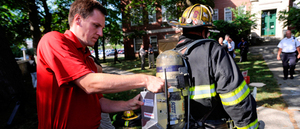
For five harrowing minutes Tuesday afternoon, Worcester emergency personnel and onlookers held their collective breath outside Kaven Hall on the WPI campus as firefighters searched for one of their own inside the building. When all of the firefighters emerged safely, applause erupted throughout the area.
While this was a training exercise, it represented the most promising development yet for tracking technologies for first responders. WPI served as the host site of the first-ever public demonstration of the Department of Homeland Security Science and Technology Directorate’s first responder location system known as GLANSER, which stands for Geospatial Location Accountability and Navigation System for Emergency Responders.
WPI in the News
Press coverage:
- The Boston Globe: Firefighter tracker to be unveiled
- NECN: New technology unveiled, the future of firefighting
- Telegram & Gazette: Demonstration of firefighter tracking system (slideshow)
- Telegram & Gazette: Worcester firefighters get tracking demo
- Firehouse Magazine: Worcester Holds Annual Locator Technology Workshop
- Firehouse Magazine: Firefighter Locator Test a Success at WPI Workshop
- Firehouse Magazine: Fire Administrator Advocates Technology at Workshop
For WPI researchers and the Worcester Fire Department, the successful simulation during the Seventh Annual International Workshop on Precision Indoor Personnel Location and Tracking Technology holds special significance. In December 1999, six Worcester firefighters died in the former Worcester Cold Storage and Warehouse Co. building.
Worcester fire officials believe that those men could have been saved with the technological advance represented by GLANSER. While DHS is funding the GLANSER product, three companies have played critical roles in its development: Honeywell developed the navigation solution, Argon ST of Fairfax, Va., built the radio and networking communications system, and TRX Systems of Greenbelt, Md., developed the display and mapping technology.
The football-sized GLANSER unit is affixed to a firefighter’s breathing apparatus and it can track and locate firefighters in three dimensions within multistory buildings using a fusion of technologies, including an ultra-wideband ranging radio, an inertial measurement unit, a Doppler velocimeter, and a barometric altimeter. Location information is transmitted to the incident command station via a mesh network that uses individual firefighter navigation units as nodes. The location of firefighters and the tracks they’ve followed are displayed on monitors at a command post.

Spurred by the deaths of the Worcester firefighters, WPI became one of the first universities to attempt to tackle the daunting challenge of locating people inside buildings, where GPS does not work. Researchers in WPI's Electrical and Computer Engineering Department developed and tested indoor location technology and technology for monitoring firefighters' vital signs.
More recently, officials have been working with WPI's Fire Protection Engineering Department on other technology aimed at increasing safety for first responder, including a sensor that can predict the onset of deadly flashover. WPI’s work has been supported by more than $5 million in funding from the Departments of Justice, the Department of Homeland Security, the Federal Emergency Management Agency, and other federal agencies.
WPI researchers were also among the first to work directly with first responders to better understand their needs, efforts that led to the inaugural workshop on precision indoor location and tracking in 2006. Since then, the workshop had brought together first responders, researchers, and representatives of industry and government to assess the state of the indoor location field and demonstrate prototype systems (including WPI's technology). Each year, the goal of a successful location system seemed just a bit closer.
Later in the afternoon of the second day of the 2012 workshop, a room filled with firefighters, scientists and government officials anxiously awaited the results of the GLANSER demonstration, wondering if this might finally be the year when the goal was achieved. As they reviewed a video presentation about the test, Worcester Deputy Fire Chief John Sullivan, who oversaw operations during the rescue demonstration, and retired Berlin, Mass., fire engineer Ric Plummer declared them a success.
Jalal Mapar, program manager for the Department of Homeland Security Science and Technology Directorate, who admitted to being quite anxious before the tests began, agreed and told the gathering the goal is to bring the GLANSER system to market in the next year or so. Sullivan, who noted that the system still has issues that need to be addressed before it is ready for deployment, said the budding technology is not meant to replace traditional firefighting techniques. Rather, he said, it will serve to augment their training.
Still, he noted, “We’re closer than we’ve ever been.”
Those words give hope to first responders everywhere.
[2012 Workshop Organizing Committee members are James Duckworth, David Cyganski and John Orr of WPI’s ECE department; Linda Carre Looft of Government and Community Relations at WPI; Colleen Sweeney, graduate administrative assistant in the ECE department; Plummer, Mapar and Sullivan.]
